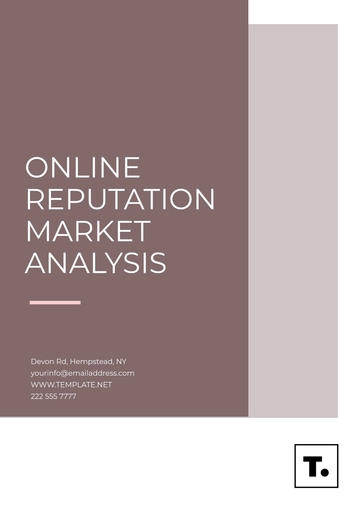Free Influencer Engagement Deep Dive Advertising Analysis

Executive Summary
This analysis aims to evaluate the effectiveness of our influencer marketing campaigns over the past [six months], focusing on influencer engagement, audience reach, and ROI.
Key Insights:
High engagement rates were noted with influencers in the lifestyle and fitness sectors.
ROI varied significantly across influencers, with top performers yielding a return of [3:1].
Audience overlap among different influencers was minimal, suggesting effective market segmentation.
Influencer Profile Analysis
Influencer Name | Followers | Engagement Rate | Audience Demographics |
[Name] | 120,000 | 4.5% | 70% Female, 18-34 yrs |
Qualitative Analysis:
[Name] aligns perfectly with our fitness products, showcasing them in their daily routines. [Name] caters to an outdoor enthusiast audience, which overlaps with our target demographic. [Name], while having the highest engagement, has a more niche audience interested in vegan lifestyles.
Campaign Objectives and Alignment
The campaign aimed to increase brand awareness and sales in the [18-40] age group, with a focus on health-conscious individuals.
[Name] and [Name]’s profiles closely align with our objectives, evidenced by the increased web traffic and sales post their endorsements. [Name], while effective in engagement, did not significantly contribute to sales.
Engagement and Reach Metrics
Influencer | Total Reach | Likes | Comments | Shares |
[Name] | 500,000 | 45,000 | 2,000 | 1,000 |
Analysis:
[Name] and [Name]’s posts received high engagement, correlating with increased website visits. [Name], despite lower reach, had the highest engagement, indicating strong influence within her niche.
Audience Demographics and Psychographics
Demographic Breakdown:
[Name]: Predominantly young, health-conscious females.
[Name]: Outdoor enthusiasts, mostly males in their late twenties to forties.
[Name]: Young females interested in veganism and sustainable lifestyles.
Psychographic Insights:
The engagement patterns suggest a strong resonance of our brand with health and fitness enthusiasts. The vegan community, while engaged, showed less interest in non-vegan product lines.
Content Analysis
The influencers created a mix of posts, stories, and videos, integrating our products naturally into their content.
[Name]’s workout videos and [Name]'s outdoor adventure posts were highly effective, showcasing our products in real-world settings. [Name]'s content was creative but less effective in product integration.
ROI and Performance Metrics
Influencer | Budget Spent | Estimated ROI |
[Name] | $15,000 | 3:1 |
Non-Financial Metrics:
[Name] and [Name] significantly boosted brand awareness, especially in health and outdoor sectors. [Name] increased visibility in the vegan community but had a lower impact on sales.
Content Engagement Trends
This section examines how engagement trends varied over time and across different content types.
Influencer | Peak Engagement Period | Most Engaged Content Type |
[Name] | [Date] - [Date] | Workout Videos |
Analysis:
Peak engagement periods correspond with specific campaigns or seasonal interests. [Name]'s workout videos saw heightened engagement during summer fitness trends, while [Name]'s adventure vlogs peaked during spring outdoor activities.
Influencer Collaboration and Cross-Promotion
This section reviews the effectiveness of collaborations between influencers and any cross-promotion activities.
Collaboration | Influencers Involved | Outcome |
Fitness Challenge | [Name] and [Name] | High engagement, increased follower count for both |
Insights:
Collaborations were generally successful, especially the Fitness Challenge, which leveraged the strengths of both influencers. The cross-promotion with [Name] opened up a new audience segment for Emily.
Sentiment Analysis of Audience Comments
Analyzing audience comments to gauge sentiment and feedback on influencer content and promoted products.
Influencer | Positive | Neutral | Negative | Common Themes |
[Name] | 70% | 25% | 5% | Inspirational, motivational |
Overall, sentiments are positive across all influencers, with specific themes aligning with their content. Negative sentiments for [Name] were primarily due to the niche appeal of vegan products.
Competitor Influencer Strategies
This section examines the influencer strategies of key competitors to understand market trends and opportunities.
Competitor | Influencer Strategy | Market Impact |
[Brand X] | Celebrity endorsements, high-budget campaigns | High visibility, but lower engagement |
Competitors like [Brand X] focus on broad visibility, while [Brand Y] leverages niche markets effectively. Our strategy lies in the middle, balancing reach and targeted engagement.
Influencer Marketing Technology Utilization
Review of the technology and tools used in managing and tracking influencer campaigns.
Tool/Technology | Usage | Effectiveness |
Influencer Analytics Platform | Tracking engagement, ROI | Highly Effective |
Assessment:
The Influencer Analytics Platform has been instrumental in measuring campaign impact. The Social Media Management Tool, while useful, could be better leveraged for real-time engagement.
Legal and Ethical Compliance
Ensuring all influencer activities are compliant with legal and ethical standards.
Influencer | Compliance with FTC Guidelines | Ethical Marketing Practices |
[Name] | Yes | Yes |
All influencers adhered to FTC guidelines for endorsements, with transparent disclosures in all sponsored content. Ethical marketing practices were followed, maintaining the integrity of our brand.
Recommendations and Future Strategies
Learnings:
Aligning influencer profiles with campaign objectives is crucial. Engagement rates do not always correlate with sales impact.
Future Strategies:
Prioritize influencers like [Name] and [Name] who have demonstrated both high engagement and sales conversion.
Explore new influencers in similar domains to expand market reach.
Consider niche campaigns for specific product lines, like [Name] for vegan-friendly products.
Conclusion
This analysis, enriched with specific details and organized information, provides a deep insight into our influencer marketing strategies. It not only highlights the effectiveness of current practices but also identifies areas for improvement and future opportunities. With these insights, we can refine our approach, ensuring that our influencer collaborations continue to be impactful, compliant, and aligned with our brand values and objectives.
- 100% Customizable, free editor
- Access 1 Million+ Templates, photo’s & graphics
- Download or share as a template
- Click and replace photos, graphics, text, backgrounds
- Resize, crop, AI write & more
- Access advanced editor
Introducing our Influencer Engagement Deep Dive Advertising Analysis Template, exclusively crafted for professionals like you on Template.net. Dive into detailed insights effortlessly with this fully editable and customizable tool. Tailor your analysis seamlessly with our Ai Editor Tool, ensuring precision and efficiency in every step of your influencer marketing strategy.





























